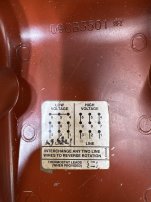cinematechnic
Cast Iron
- Joined
- Apr 11, 2005
- Location
- Walnut Creek, CA
So... I've got my 380V 3Ø Schaublin 102 lathe running off my "reconditioned" Arco Roto-Phase MG. The 246V (my panel is only 80 ft from the transformer) single phase input produces apx. 440 V at the motor (440 V L1-L2/L1-L3 and 460 V L2-L3). The transformer is P 220V : S 380V.
The Schaublin is very smooth and quiet when running (just the spindle, at low speed, motor at 900 rpm). The Roto-Phase is very noisy (buzzy, groany sound) when idling and quiets down considerably when loaded by the lathe motor.
This leads me to the idea to convert the Roto-Phase, which is self starting (two 40 µF caps in parallel between L2-L3) to a balanced configuration to reduce the noise during idling (which would eventually annoy the hell out of me). Also, the option would be there in the future to add another idler if I need more system capacity.
I've been going back through the threads, about 30 pages worth so far, and I understand the basics, but I have a few questions still:
1. I've seen frequent mention of a 40:60% ratio in running capacitor sizes. What's the reason for this, and on which side should the larger capacitance be placed?
I could easily accomplish this by placing the 40 µF caps across the two different lines, and adding a 20 µF cap, but this would raise the total capacitance to 100 µF. Is this desirable or should it be avoided?
2. Since my power is already above 240V, I would prefer to use start caps rated higher than 240V for the extra safety margin. Can anyone suggest a source for these?
I checked Surplus Center but they only seemed to have 220V rated start caps. Also, how do I determine the correct amount of start capacitance? Peter H suggested 400 µF (thanks!)
What are the advantages/disadvantages of more or less starting capacitance? Also, I understand that the start cap should go on the same side as the larger running capacitance.
3. The motor, a 1982 vintage Swiss RCB two-speed metric (IEC?) 100L C-Face motor is being run at 16% above rated voltage. Is this a risk to the motor windings? I can't get the voltage any lower since I'm already on the lowest transformer output tap. The only option would be another transformer on the 245V side.
All for now. Thanks in advance and Happy New Year...
-Jorge
CinemaTechnic
The Schaublin is very smooth and quiet when running (just the spindle, at low speed, motor at 900 rpm). The Roto-Phase is very noisy (buzzy, groany sound) when idling and quiets down considerably when loaded by the lathe motor.
This leads me to the idea to convert the Roto-Phase, which is self starting (two 40 µF caps in parallel between L2-L3) to a balanced configuration to reduce the noise during idling (which would eventually annoy the hell out of me). Also, the option would be there in the future to add another idler if I need more system capacity.
I've been going back through the threads, about 30 pages worth so far, and I understand the basics, but I have a few questions still:
1. I've seen frequent mention of a 40:60% ratio in running capacitor sizes. What's the reason for this, and on which side should the larger capacitance be placed?
I could easily accomplish this by placing the 40 µF caps across the two different lines, and adding a 20 µF cap, but this would raise the total capacitance to 100 µF. Is this desirable or should it be avoided?
2. Since my power is already above 240V, I would prefer to use start caps rated higher than 240V for the extra safety margin. Can anyone suggest a source for these?
I checked Surplus Center but they only seemed to have 220V rated start caps. Also, how do I determine the correct amount of start capacitance? Peter H suggested 400 µF (thanks!)
What are the advantages/disadvantages of more or less starting capacitance? Also, I understand that the start cap should go on the same side as the larger running capacitance.
3. The motor, a 1982 vintage Swiss RCB two-speed metric (IEC?) 100L C-Face motor is being run at 16% above rated voltage. Is this a risk to the motor windings? I can't get the voltage any lower since I'm already on the lowest transformer output tap. The only option would be another transformer on the 245V side.
All for now. Thanks in advance and Happy New Year...
-Jorge
CinemaTechnic


